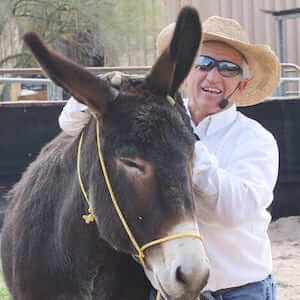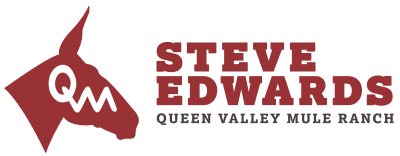
The Life of A Mule Ridin' Cowboy
In 1981 Steve Edwards got thrown by a mule named “Casper” and the owner said, “Well, I guess you don’t want to buy this mule.” Steve answered, “I’m going to buy this mule and get even with him… and our story begins there.
Family and the Early Years
I was born in Erwin, Tennessee, and was raised in Mesa, Arizona. Except for my first four years in Tennessee and one year in Michigan, I have spent my whole life in Arizona.
I am the eldest of three sons; my younger brothers are Paul and Roy. My dad, Steve Senior, was in the Air Force and my mother, Jewell, was a housewife when I was growing up. In 1968, I graduated from Westwood High School in Mesa.
I have been married to my fantastic wife, Susan, since July 1968. Together we ranch-raised two children. We now have 5 grand kids and 1 great grandchild.
The Life of A Cowboy
I took on my first ranching job with Dana Cattle Company at age twelve. During my first year of marriage, I realized that earning $25 a day punching cows was not going to put my kids through college, so I got into the automotive collision business. In 1991, I went back to cowboying, this time with my focus on training for the public.
Susan is also very involved in our ranch business, Queen Valley Mule Ranch, Inc. For one, she is the bookkeeper. Additionally, she prepares for and helps with the pack trips and various outings. She also runs all of the behind-the-scenes work at our 20-acre ranch.
We offer clinics on understanding and training mules, donkeys and their owners. With the focus on partnership with the mule, we teach people how to drive wagons, pack mules, and trail ride.
My earliest memory of mules comes from my cattle ranch experience. We packed block salt on mules to deliver it to the cattle in the fields. I thought that mules were dumb and were only to be used at a time such as this, when a decent horse should not be used. However, over the next few years, a lot of old cowboys told me that the best thing to ride, especially in rough country, is a mule. I took the old timers’ advice and I bought my first mule fifteen years ago.
I spent time studying my mule and found that there are significant differences between horses and mules. Our Arizona ranch borders the Superstition Wilderness. It is extremely rough country with lots of canyons and rocks, with only a few maintained trails. It is a great place to watch a mule work. A mule is very sure-footed. When he puts his foot down, it is right where he wants it. As water is scarce in this area, a mule is preferable to a horse because a mule can go all day without water.
Maintaining a mule is less expensive. You can feed two mules for what it takes to feed one horse. Mules are more tolerant of the heat and they rarely develop colic.
Mules are very intelligent. Once a particular training technique has been used on a mule three times, the mule understands what it is he is supposed to do. Mules get their natural abilities from the donkey.
The Dream
Many people have the same misconceptions about mules that I once had. “Mules are stubborn”. You read and hear about a stubborn mule but what I have found is that mules are not stubborn..they are just very detailed in their thinking.
Let me give you an example in a story:
I was doing a clinic in Pennsylvania and a lady came up to me and said, “My mule is stubborn.” And I asked her why she thought it was stubborn? She said, “When I want to ride away from other animals, it will go a short ways and then come back to the other animals.” I asked her to demonstrate.
She rode about 100 yards from the other mules, and sure enough, it turned and came back to the animals–even though she was pulling hard on the bridle and calling it lots of names it shouldn’t be called.
I said, “That is really an incredible demonstration! May I try your mule out?”
I showed her that she first needed to change the bridle. The bridle she was using was a finish bridle, and when you are training, you must use a training bit called a snaffle. The snaffle bit communicates to the tongue, the bars and the corners of the mouth. By using this style of bit, I can communicate correctly in my training. I have designed a bridle and bit I call the Mule Rider’s Martingale.
Two things happen when a mule wants to disagree with you. First, the nose sticks out. Then the head elevates. When the mule does this, he then can control you, and just like the Pennsylvania lady the mule controlled the situation. I put my Mule Riders Martingale on, adjusted the saddle to fit me, and adjusted the saddle so it was comfortable on the mule. I then got on the mule and started to ride off. When the mule wanted to turn back to the right, I used my right leg, calf first, side of the stirrup second, and spur third. By doing that, I was communicating naturally to the mule, and the mule understood this natural way to communicate. So by using my legs I was able to show the mule that going to the right is going to make him uncomfortable.
To make a long story short, I rode the mule anywhere I wanted to go, because I didn’t use just my hands and my voice, but my legs also.
So my dream is to fully communicate from the saddle using less to get more. Most people would use the spur, which then makes the mule scared or dull. On the ground communication is extremely important. Using correct adjusted halters, and round pen communication you can build a foundation of communication on the ground, before you get into the saddle.
Experience
Most of my mule education was from the school of hard knocks, and listening to wiser men. I have learned a great deal from fellow cowboys Tom Dorrance, Delos Burke, Nick West and Bud Brown.
I have logged countless hours packing throughout Arizona and many other Southwestern states. I also have specific experience in the following areas:
- Packing for the Park Services in Yosemite National Park.
- Packing for the National Forest Services in Arizona.
- Packing at the Grand Canyon.
In September 1998, I began a project of training twelve mules for a riding and driving program at the Phoenix Zoo. I trained zoo workers to present informational programs on mules, their history and their abilities. The mules are part of a greater zoo program known as Harmony Farms. In the mule portion of the program, urban families are introduced to mules as they were used during the beginning of Arizona’s statehood.
During 2002, I was instrumental in establishing the first Mule Training Apprenticeship Program in an American College. This program enables a student to earn a Certificate of Achievement in Mule Training. This is a 2 year, 16 credits program. The mule program is part of the newly expanded equine program at Pierce College in Woodland Hills, California.


